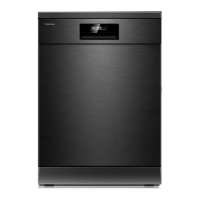
Do you have a question about the Toshiba DW-15F3(BS)-NZ and is the answer not in the manual?
| Brand | Toshiba |
|---|---|
| Model | DW-15F3(BS)-NZ |
| Category | Dishwasher |
| Language | English |
Explains warning labels, symbols, and their meanings for safe operation.
Covers warnings like child safety, modification prohibition, and electric shock precautions.
Guidelines for safe handling of power plugs, cords, and sockets.
Rules for preventing water spray, fires, and managing dust accumulation.
Steps for proper plug insertion, heat source separation, and placement.
Explains the necessity of grounding for electric shock prevention.
Advice on unplugging, correct detergent use, and avoiding climbing on the unit.
Notes on application environment, long-term storage, and error attention.
Rules for loading capacity, preventing finger pinching, and avoiding burns from hot water.
Guidelines on filter setting, preventing misuse, and ensuring stable installation.
Information on handling, recyclability, and proper disposal of packaging materials.
Identifies key internal components like spray arms, filter, and dispenser for user familiarization.
Explains the power button and descriptions of various washing programs available.
Details on selecting upper or lower basket loading for washing different items.
Covers special functions like Power Wash, Turbo Speed, Sanitization, and indicators.
A comprehensive table detailing each program's temperature, powder, time, power, and water usage.
Step-by-step instructions for initial startup and running the appliance.
Procedure to modify the selected wash program while it is running.
Instructions for reloading dishes after the wash cycle has begun.
Description of the automatic door opening function for enhanced drying.
Steps to take after the wash cycle is completed, including turning off and safely removing dishes.
Explains the roles of rinse aid and detergent in the dishwashing process.
Guidance on refilling the rinse aid dispenser and proper use of detergent.
Detailed steps for correctly filling the rinse aid reservoir.
How to set the dishwasher's rinse aid dosage based on user habits.
Instructions for opening the detergent dispenser and adding the correct amount.
Advice on compatible dishware and general loading principles for efficiency.
Specific guidance on placing small items, hollowware, and sharp utensils safely.
How to load delicate items like cups, glasses, and small plates in the upper rack.
Guidance on loading larger items like dinner plates and soup plates in the lower rack.
Instructions for arranging forks, spoons, knives, and other cutlery for optimal cleaning.
Tips for easy cutlery removal and maximizing space within the baskets.
Instructions on how to adjust the height of the upper basket for different dish sizes.
How to fold or remove cup shelves to accommodate taller items in the upper basket.
How to fold down the spikes in the lower basket to create more space for platters.
Step-by-step instructions for removing, cleaning, and reassembling the dishwasher filters.
Instructions for detaching and cleaning the upper and lower spray arms to maintain performance.
Guidance on safely cleaning the door seals and the electronic control panel.
Detailed measurements of the dishwasher's height, width, and depth for installation planning.
Essential information on power supply voltage, frequency, grounding, and socket types.
Instructions for correctly connecting the cold water supply hose to the appliance.
Guidelines for connecting the drain hose, including height limits, extensions, and overflow management.
A guide to common checks before contacting customer service for appliance problems.
Solutions for issues related to the machine not starting or insufficient water drainage.
Troubleshooting steps for problems like excessive foam, colored marks, or rust on dishes.
Solutions for noises, improperly cleaned dishes, and dull glassware.
Addressing issues like imprints, detergent residue, and incomplete drying of dishes.
Explanation of specific error codes displayed by the dishwasher and their potential causes.
Key specifications including model number, dimensions, voltage, frequency, and power consumption.
Details on manufacturer, place settings, energy efficiency, and consumption class.